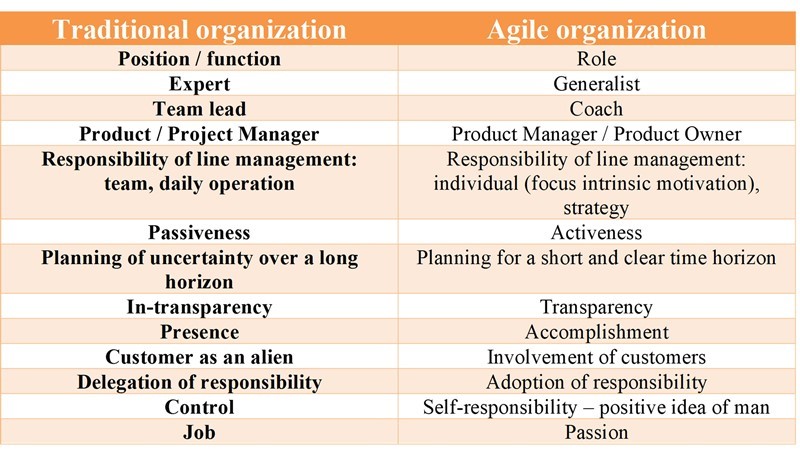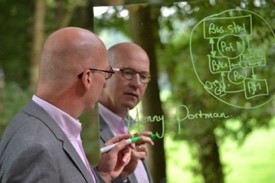Sensemaking in the Agile Forest
SERIES ARTICLE
By Henny Portman
The Netherlands
Introduction[1]
We all know Peter Drucker’s famous quote ‘Culture eats strategy for breakfast’ and I transformed that into ‘Culture makes or breaks your agile transition’. For me this is reason number one why so many agile transitions fail. In this article I explain what I mean with culture, I make some references to books or articles explaining culture and I make a reference to my Bird’s eye view on the agile forest and elaborate on the, what I call, culture-targeted frameworks or ways of working.
Culture
The last three or four Annual State of Agile Reports[2] show that one of the Leading causes of failed agile projects is the observation ‘Organizational culture at odds with agile values’.
If I look at culture in relation to change, I am looking at the values of the organization, the structure of an organization, the expectations we have, the practices we use and the behaviors we show.
Dominik Maximini made a great comparison between a traditional organization and an agile organization in his book The Scrum Culture[3].

Jeff Sutherland wrote in his article Agile at Scale (Harvard Business Review)[4] ‘No agile team should be launched unless and until it is ready to begin!’ He states that an agile team is ready when it is:
- Focused on a major business opportunity with a lot at stake
- Responsible for specific outcomes
- Trusted to work autonomously – guided by clear decision rights, properly resourced, and staffed with a small group of multidisciplinary experts who are passionate about the opportunity
- Committed to apply agile values, principles, and practices
- Empowered to collaborate closely with customers
- Able to create rapid prototypes and fast feedback loops
- Supported by senior executives who will address impediments and drive adoption of the team’s work.
Jack Duggal looks in his book The DNA of strategy execution whether organizations are organized to execute or organized to learn.

When I look at culture, I am looking for the mindset of people. Are we solving problems or are we exploring opportunities, are we reactive or proactive, are we anxious or do we trust each other (including management), can we make mistakes (as long as it goes fast, and we don’t do it twice) or are no mistakes allowed. Are we making decisions at the lowest possible level or is decision-making centralized? Decision making and how long it takes before decisions have been made is the key topic and reason for project failure in one of Standish group’s CHAOS Reports[5].
More…
To read entire article, click here
Editor’s note: This article series is by Henny Portman, one of the world’s leading authorities on “agile”. Based in The Netherlands, Henny coined the term “agile forest” in 2019 to describe the many agile frameworks that have emerged over the last 20 years. This series is intended to help readers better understand the agile concept, navigate through the ‘underbrush’ and more successfully apply whichever framework is selected for their projects.
How to cite this article: Portman, H. (2023). Culture makes or breaks your agile transition, Sensemaking in the Agile Forest series, PM World Journal, Vol. XII, Issue V, May, Available online at https://pmworldlibrary.net/wp-content/uploads/2023/05/pmwj129-May2023-Portman-Culture-makes-or-breaks-your-agile-transition.pdf
About the Author

Henny Portman
The Netherlands
![]()
Henny Portman, owner of Portman PM[O] Consultancy and was partner of HWP Consulting, has 40 years of experience in the project management domain. He was the project management office (PMO) thought leader within NN Group and responsible for the introduction and application of the PMO methodologies (portfolio, program, and project management) across Europe and Asia. He trains, coaches, and directs (senior) programme, project and portfolio managers and project sponsors at all levels, and has built several professional (PM(O)) communities.
Henny Portman is accredited in a variety of qualifications, including P3O, PRINCE2, MSP, MoP, PRINCE2 Agile, AgilePM, AgilePgM and AgileSHIFT trainer and an SPC4 SAFe consultant and trainer. He is a P3M3 trainer and assessor and PMO Value Ring Certified Consultant (PMO Global Alliance). On behalf of IPMA, he assesses mega and large projects for the IPMA Project Excellence Award. In addition to this, he is an international speaker, author of many articles and books in the PM(O) field, and an active blogger. More at hennyportman.wordpress.com
Henny can be contacted at henny.portman@gmail.com
To view other works by Henny Portman, visit his author showcase in the PM World Library at https://pmworldlibrary.net/authors/henny-portman/
[1] This article is an updated version of the agile culture article in Blue Striped Frog – The agile community – Magazine (2nd edition) 2021
[2] https://stateofagile.com/#
[3] Maximini, Dominik (2016). The Scrum Culture, Springer, Switzerland
[4] HBR, MAY-JUNE 2018, Agile at scale
[5] Standish Group, CHAOS Report 2018: Decision Latency Theory: It’s All About the Interval









